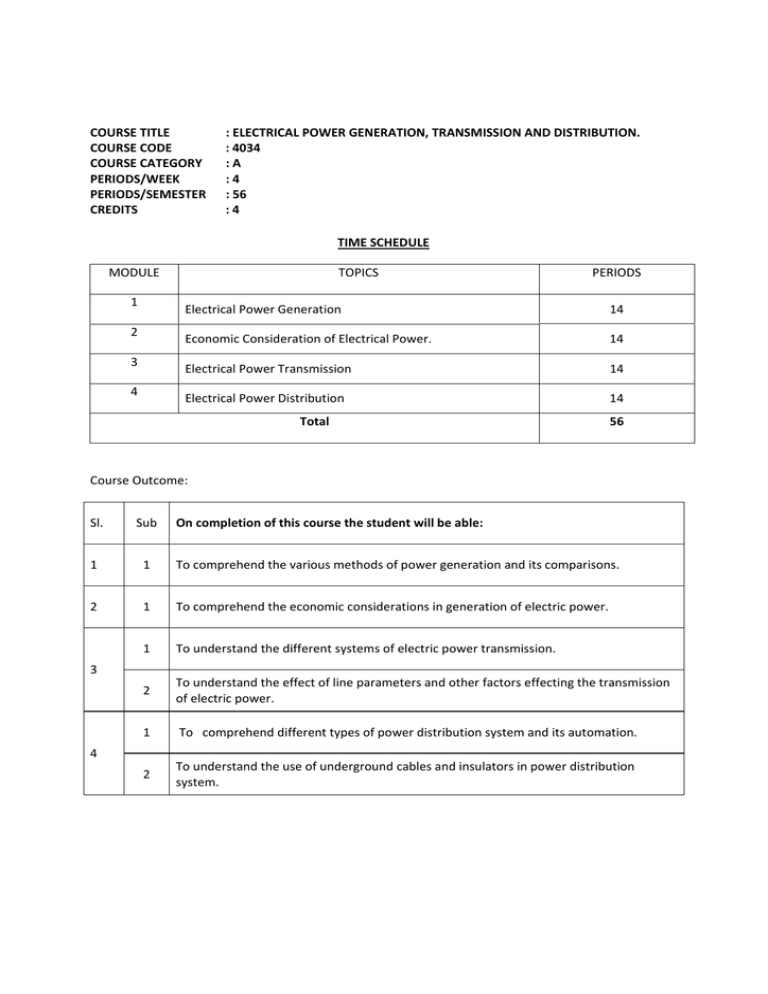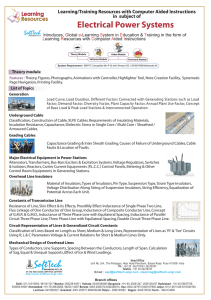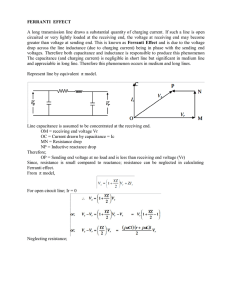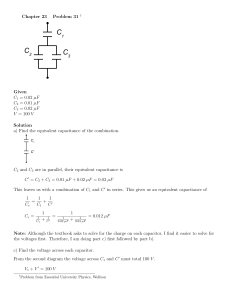Electric Power Generation, Transmission
advertisement

COURSE TITLE COURSE CODE COURSE CATEGORY PERIODS/WEEK PERIODS/SEMESTER CREDITS : ELECTRICAL POWER GENERATION, TRANSMISSION AND DISTRIBUTION. : 4034 :A :4 : 56 :4 TIME SCHEDULE MODULE 1 2 3 4 TOPICS PERIODS Electrical Power Generation 14 Economic Consideration of Electrical Power. 14 Electrical Power Transmission 14 Electrical Power Distribution 14 Total 56 Course Outcome: Sl. Sub On completion of this course the student will be able: 1 1 To comprehend the various methods of power generation and its comparisons. 2 1 To comprehend the economic considerations in generation of electric power. 1 To understand the different systems of electric power transmission. 2 To understand the effect of line parameters and other factors effecting the transmission of electric power. 1 To comprehend different types of power distribution system and its automation. 2 To understand the use of underground cables and insulators in power distribution system. 3 4 Specific Outcome: MODULE I Electrical Power Generation 1.1.1 1.1.2 1.1.3 1.1.4 To identify the different sources of power and their relative importance. To differentiate conventional and non conventional methods of power generation. To identify the factors governing location of various types of power station. To draw schematic layout of; i. Hydroelectric power stations. ii. Steam power plants. iii. Diesel power plants. iv. Gas power plants. v. Atomic power plants. 1.1.5 To select essential equipment in these power stations. 1.1.6 To determine the co-ordination of different power stations in the system. 1.1.7 To identify the equipment used in Power station. 1.1.8 To draw the layout of power station. 1.1.9 To differentiate various power stations. 1.1.10 To draw the layout of power station switch yard and to identify the equipment. 1.1.11 To solve simple problems regarding the quantity of electricity generated from the available quantity of water. 1.1.12 To solve simple problems regarding the quantity of electricity generated in a thermal power station. MODULE II Economic Consideration of Electrical Power. 2.1.1 2.1.2 2.1.3 2.1.4 2.1.5 2.1.6 2.1.7 2.1.8 To compare capital and operational cost of various types of power stations To state the terms- load estimate, demand factor, load factor, diversity factor, load curve. To solve simple problems regarding the above factor. To describe the Interconnection of power stations and combination. To distinguish the base load and peak load. To solve problems about operational schedule based on base load, peak load and other factors. To compare various Tariff systems. To determine the cost of energy based on Tariff. MODULE III Electrical Power Transmission 3.1.1 3.1.2 3.1.3 3.1.4 To describe typical power supply transmission (both OH & UG based on voltage) schemes. To illustrate systems of transmission based on voltage. To identify the materials used as conductors and supporting structures. To determine the sag in conductors due to supports (equal and unequal levels). 3.2.1 3.2.2 3.2.3 3.2.4 3.2.5 3.2.6 3.2.7 To state transmission line parameters, resistance, inductance and capacitance. To find the resistance inductance and capacitance of two wire and three wire supply lines. To explain why the transposition of line conductors is essential. To illustrate the performance characteristics of short transmission lines. To determine the line losses, efficiency and regulation of short lines and condition for maximum regulation. To Illustrate Ferranti effect, phenomenon of corona, skin effect, corona power loss. To determine sending end voltage, current, power factor, regulation and efficiency of medium long lines. MODULE IV Electrical Power Distribution 4.1.1 4.1.2 4.1.3 4.1.4 4.1.5 To discriminate feeders, distributers and service mains. To describe different methods of distribution and their comparison. To state voltage regulation. To describe the different voltage regulating devices. To describe the methods of power factor improvements in distribution system. 4.2.1 4.2.2 4.2.3 4.2.4 4.2.5 4.2.6 4.2.7 4.2.8 4.2.9 To identify different types of insulators used in distribution system. To identify the different causes of failure of insulators. To determine the string efficiency. To describe methods of improving string efficiency. To classify different types of underground cables. To describe the construction of underground cables. To state grading of cables, capacitance and inter sheath grading. To describe methods of laying cables. To Illustrate EHV and HVDC. CONTENTS MODULE- I Conventional and nonconventional energy sources – comparison - Generation of electrical energy Selection of sight – hydroelectric – thermal and nuclear power plants - Detailed layout - explanation and comparison of hydro electric – thermal and nuclear power plants - calculation of total electrical energy generated in hydroelectric and thermal power stations - problems. MODULE –II Types of electrical loads - load on power station - load curve – terms – factors - connected load - Max. Demand – demand factor – load factor – diversity factor – capacity factor – plant use factor- problems Base load - peak load – interconnected grid system- reason for interconnection- problems - Tariffs – objectives of tariffs – types of tariffs - comparisons – simple tariff- flat rate tariff- block rate tariff- two part tariff- maximum demand tariff- power factor tariff - problems. MODULE –III Electric supply system – Single line diagram of a typical supply scheme – Components- comparisons Various systems of power transmission-comparison - DC system – Single phase system – Two phase Three phase - Over head line components - Conductor materials – Line supports – Insulators – String efficiency- Sag (equal and unequal levels) – Transmission line parameters Two wire and three wire – calculation – Resistance - Inductance – Capacitance - Transposition. Classification of over head transmission lines - Line losses - Voltage regulation - Transmission efficiency Ferranti effect - Corona – Skin effect - Problems. MODULE –IV Distribution system - components – feeders- distributers – service mains- methods(connections scheme) of distribution – comparisons- OH and UG- requirements of distribution system- voltage regulation – voltage regulating devices- power factor improvements – different types of insulators- causes of failure of insulators- string efficiency- underground cables- construction – classification – grading- methods of cable laying- EHV and HVDC applications. REFERENCES 1. VK Mehtha. Rohit Mehtha. Principles of Power System: S Chand & co. 2. J B Gupta. A course in Power Systems: S K Kataria &sons.





